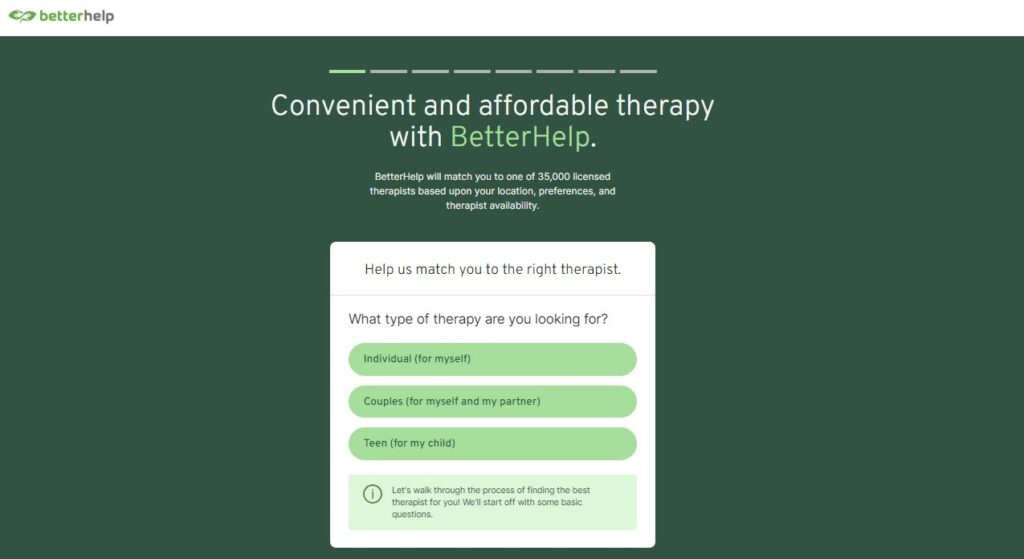Autism spectrum disorder (ASD) is an umbrella term that encompasses autism, pervasive developmental disorders, and Asperger’s syndrome. If you have been diagnosed with autism or you’re parenting a child that’s been diagnosed with ASD, finding the right therapist can be overwhelming.
In this article, we’ve looked at platforms that can help to connect you with a therapist specializing in autism. We’ve also explained the most common therapeutic approaches used for treating autism and autism spectrum disorders.
Want to skip right to the suggestions for autism therapists? Here are our 5 recommended therapy solutions:
Autism Therapist Near Me
Below, we’ve looked at five places where you can find a therapist to help you or your family member with autism spectrum disorder. Some of these providers offer online therapy given the occasional difficulty in locating a therapist nearby due to geographical constraints.
| Povider | Good For | Location | Pricing |
|---|---|---|---|
| BetterHelp | Quick match with the right therapist four you | Online therapy | $65 to $90 per week (billed every 4 weeks) |
| Online-therapy.com | Finding licensed and experienced therapists with a Cognitive Behavioral Therapy (CBT) approach | Online therapy | $40/week to $88/week (including our 20% discount first month) |
| Calmerry | Depression therapy, online grief counseling, anxiety therapy, therapy for OCD, self-esteem therapy | Online therapy | $49.50 to $73.75 per week (billed monthly) |
| TalkSpace | Depression, anxiety, bipolar disorder, OCD, PTSD, LGBTQIA+ therapy | Online therapy | Varies according to insurance coverage or self-pay options |
| Neurodivergent Therapists | Connecting people with autism spectrum disorder with therapists in their state | Online and in-person therapy worldwide | Varies depending on the counselor fee |
1. BetterHelp

Explore emotional well-being with BetterHelp – your partner in affordable online therapy. With 30,000+ licensed therapists and plans starting from only $65 per week, BetterHelp makes self-care accessible to all. Complete the questionnaire to match with the right therapist.
- Good for: Quick match with the right therapist four you.
- Location: Online therapy.
- Pricing: $65 to $90 per week (billed every 4 weeks).
- Features: iOS and Android app available, message your therapist anytime, live sessions are scheduled weekly and done via live chat, phone, or video call.
BetterHelp is an online therapy platform that can connect you with a therapist who has extensive experience in treating autism spectrum disorder. All the therapists on this platform are licensed, accredited professionals offering help for a wide variety of issues, including autism spectrum disorder.
Read our BetterHelp review here.
2. Online-therapy.com

Discover transformative online therapy with Online-therapy.com. Through cognitive behavioral therapy (CBT), Online-therapy.com offers individual and couples support starting at $45/week. Engage in sessions via video, voice, or text for maximum flexibility. Fill out their online questionnaire to get started.
- Good for: Finding licensed and experienced therapists with a Cognitive Behavioral Therapy (CBT) approach.
- Location: Online therapy.
- Pricing: $40/week to $88/week (including our 20% discount first month).
- Features: Unlimited messaging with your therapist, including a daily journal and activity plan, yoga and meditation videos, and tests to see your progress.
Online-therapy.com is a platform that aims to make mental health care accessible and convenient, utilizing online communication methods to connect individuals with licensed therapists and counselors with experience in diverse areas, including autism.
Read our online-therapy.com review here.
3. Calmerry

Embark on a journey of mental wellness with Calmerry. With diverse subscription options, starting at just $50, Calmerry makes prioritizing your mental health simple and accessible. You can message your therapist any day or schedule a live therapy session from the comfort of your home from any device.
- Good for: Depression therapy, online grief counseling, anxiety therapy, therapy for OCD, self-esteem therapy.
- Location: Online therapy.
- Pricing: $49.50 to $73.75 per week (billed monthly).
- Features: Message to your counselor anytime, text therapy and video therapy according to the plan you choose, free counselor switching.
Calmerry employs a matching algorithm that takes into account the information provided in the intake questionnaire. The algorithm aims to pair you with a therapist with experience in autism who aligns with your specific requirements and goals.
Read our comparison between Calmerry and BetterHelp here.
4. TalkSpace

Tailored to individuals, couples, teens, and offering psychiatry services, Talkspace plans kick off at a wallet-friendly $69 per week. What’s more, many health insurances also cover their services, enhancing accessibility and affordability. Complete a questionnaire and get matched with the right therapist for you.
- Good for: Depression, anxiety, bipolar disorder, OCD, PTSD, LGBTQIA+ therapy.
- Location: Online therapy.
- Pricing: Varies according to insurance coverage or self-pay options.
- Features: Accepts insurance, pick your therapist from a list of recommendations, live video sessions and unlimited messaging with your therapist, medication management.
In TalkSpace you must complete an initial assessment, which helps Talkspace understand your mental health needs and preferences, there you can mention you are looking for a therapist with experience in addressing autism.
Read our TalkSpace review here.
5. Neurodivergent Therapists

- Good for: Connecting people with autism spectrum disorder with therapists in their state.
- Location: Online and in-person therapy worldwide.
- Pricing: Varies depending on the counselor fee.
- Features: Online directory, neurodiversity-affirming therapists, contact therapists directly.
Neurodivergent Therapists is an online directory that lists only neurodiversity-affirming therapists. Therapy offered on the site is centered around the neurodiversity paradigm, an approach that seeks not to “fix” people on the spectrum, but instead offers techniques and strategies to recognize their unique traits and strengths.
Online vs. Face-to-face Autism Therapy

Autism spectrum disorder (ASD) is a complex condition that may require different therapeutic approaches depending on its severity. For this reason, it has previously been thought that online therapy couldn’t treat autism as effectively as face-to-face therapy.
However, in recent years, studies have shown the clear benefits of online therapy in treating autism.
Treating autism can be extremely time-consuming. For example, Applied Behavioral Analysis (ABA), regarded as one of the most efficient autism treatments, takes up to 26 to 40 hours a week, depending on the severity of the disorder. Usually, this isn’t the only type of therapy that children have to partake in to effectively treat autism.
The online version of this type of therapy wouldn’t be much shorter, but it avoids having to travel to your therapist every day, and sit in traffic. It doesn’t matter whether you’re an adult with autism or a parent of an autistic child, you can save a lot of time by attending online sessions.
Another benefit of online therapy is the ability to participate in sessions from your own home, which can mean a lot to children with autism, because they can relax and be more comfortable while getting help in their own environment.
A study on autism therapy by Stanford Medicine researchers, which used a behavioral method called Pivotal Response Treatment (PRT), found that this type of treatment becomes easier when applied online.
The core principle of this method is encouraging the patient with ASD to engage in a desired behavior, which in this example is a meaningful conversation about a subject matter that the patient finds interesting. The study found that online sessions made finding a specific subject the patient is interested in easier and faster, allowing therapy to achieve greater progress in less time.
However, if you or your child have more severe behavioral issues associated with autism, and you are in need of immediate, close assistance, it is a good idea to seek out treatment in person – especially if your child is at risk of hurting themselves or others through their behavior.
What Certifications do Autism Therapists Have?
When searching for an ASD therapist, it can be helpful to find a professional who is certified to help treat autism and related disorders.
There are a few different certifications that are relevant:
- A Certified Autism Specialist (CAS) is an individual who specializes in providing support and service to people with ASD. In order to obtain this certificate, the therapist has to have a graduate degree, at least two years of experience working with autism, and must pass an autism competency test.
- A Speech-Language Pathologist (SLP) specializes in communication and social skills. To become an SLP, a person must graduate in speech pathology, and pass a speech-language examination.
Some other certifications to look for when searching for an ASD therapist are Autism Certificate (AC), Registered Behavior Technician (RBT) and Board Certified Behavior Analyst (BCBA), all of which require extensive training, and passing an autism competency exam. The first certification is a broader one for people who have experience working with autism, while the latter two are for more specific roles in the process of helping with behavior modification, issued by the Behavior Analyst Certification Board.
Therapies Used to Treat ASD

There are a number of different psychotherapeutic and other treatments used to help people with autism spectrum disorder.
Behavioral Therapies
This set of methods and techniques focuses on behavioral symptoms that people with autism spectrum disorder might have, such as restrictive, repetitive behavior, or anger management issues.
Some examples of these behaviors are repetitive motor movements, like hand flapping, or lining up items, and restrictive behavior such as having to take the same route every day, or requiring that activities are completed in the same order. Straying from these routines can sometimes cause anxiety or even aggression in people with ASD.
One of the widely used therapies for treating these behaviors is Applied Behavioral Analysis or ABA for short. ABA encourages desired behavior and discourages undesired behavior with the goal of improving your quality of life.
This therapeutic approach most commonly uses two distinct teaching styles: Discrete Trial Training (DTT) and Pivotal Response Training (PRT).
- Discrete Trial Training (DTT) offers step-by-step instructions to teach desired behaviors. For example, a complex behavior might be broken down into smaller sections, and each section would be encouraged or discouraged, such as through practical activities, especially in a clinical setting, with the help of a trainer.
- Pivotal Response Training (PRT) is a more immersive strategy that focuses on learning desired behaviors in natural rather than clinical settings. For example, a child might start talking about a stuffed animal, and since conversation is a desired behavior, the child will be encouraged to continue this behavior, while playing with their stuffed animal.
Applied Behavioral Analysis is a useful approach when treating adults, too. With this approach, adults with autism can learn some specific behaviors, such as dining in a restaurant or using public transportation.
However, since Applied Behavioral Analysis is a behavioral approach based on conditioning, it’s important to note that changing adult behaviors and overriding years of learned behaviors often takes time and patience. It may take months or even years of ABA treatment to help you achieve a better quality of life.
Developmental Approaches

People with autism can have significantly impaired developmental skills, such as physical or communicational skills. Developmental approaches are often combined with a behavioral approach to improve developmental skills.
One of the most commonly used techniques in this approach is speech and language therapy, aimed at improving the person’s understanding and use of speech and language. This type of treatment is sometimes carried out by a speech-language pathologist.
Another important technique is occupational therapy, which seeks to help people with ASD live as independently as possible.
Developmental approaches can be helpful to adults with autism, as well. Speech and language therapy is used to improve verbal and non-verbal communication, and occupational therapy can help people to become more comfortable with daily tasks.
Social–Relational Approaches
With impaired communication and language skills, navigating social situations and reading social cues can be difficult for people with autism.
Social-relational models focus on increasing the person’s engagement, motivation, and interest by encouraging parents, therapists, and peers to interact with the person and improve their communication and social skills. These techniques might include playtime or storytelling, for example.
There’s even the possibility of participating in social skills groups that provide an inclusive environment for people with ASD to practice social skills.
Psychological Approaches

Cognitive-Behavioral Therapy (CBT) is one of the most effective psychotherapeutic approaches used to help improve mental health. As it relates to autism, it encompasses understanding social situations and recognizing emotions, as well as connecting thoughts, behaviors, and emotions.
Working through an autism diagnosis can be stressful, and can even cause anxiety or depressive symptoms. CBT helps alter negative beliefs and thoughts and establish healthier thought patterns, through a process of talk therapy.
Pharmaceutical Approaches
There are instances when pharmacotherapy might be indicated for people with ASD. It’s important to note that there is no medication that cures autism or autism spectrum disorders, but some can be prescribed for treating specific symptoms.
For example, people with ASD might experience anxiety, depressive symptoms, high energy levels, or even sleep problems. A psychiatrist might prescribe medication to make these symptoms more manageable.
If you think you or your child might need pharmacotherapy, make sure to talk to your doctor or a psychiatrist. A therapist can also help explore your options in this area.
Conclusion
Autism and autism spectrum disorders are complex diagnoses with many different therapeutic approaches. Deciding which one is the best for you or your child is a difficult decision that takes a lot of research.
Platforms such as the ones we describe above make finding a proper professional for autism treatment easier and more convenient. If you’re still not sure how to find the right therapist for help with autism, feel free to contact us and we’ll get back to you.





